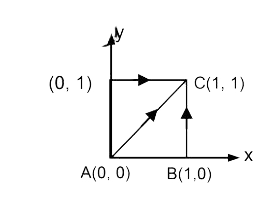A particle moves in the x-y plane under the action of a force →F such that the value of its linear momentum →P at any time t is Px=2cost and Py=2sint. What is the angle θ between →F and P at a given time t?
90∘
0∘
180∘
30∘
The correct Answer is:A
P=√P2s+P2y=√(2cost)2+(2sint)2=2
If m be the mass of the body, then
Kinetic energy = P22m=(2)22m=2m
Since kinetic energy does not change with change with time, both work done and power are zero.
Now power =Fvcosθ=0
As F≠0,v≠0 ∴ cosθ=0 or θ=90∘
As direction of →P is same that →v(∵'→P=m→v), hence angle between →F and →P is equal to 90∘.
Topper's Solved these Questions
- WORK, ENERGY, POWER AND COLLISIONBOOK - A2ZCHAPTER - WORK, ENERGY, POWER AND COLLISIONEXERCISE - Assertion Reasoning
17 Videos
- WORK, ENERGY, POWER AND COLLISIONBOOK - A2ZCHAPTER - WORK, ENERGY, POWER AND COLLISIONEXERCISE - NEET Questions
49 Videos
- WORK, ENERGY, POWER AND COLLISIONBOOK - A2ZCHAPTER - WORK, ENERGY, POWER AND COLLISIONEXERCISE - Collision
31 Videos
- WAVES AND ACOUSTICSBOOK - A2ZCHAPTER - WAVES AND ACOUSTICSEXERCISE - Chapter Test
30 Videos
Similar Questions
A particle moves in the x-y plane under the action of a force →F such that the value of its linear momentum →P at any time t is Px=2 cost and py=2sint. What is the angle θ between →F and P at a given time t?
View SolutionA particle moves in the xy-plane under the action of a force F such that the components of its linear momentum p at any time t are px=2cost, py=2sint. The angle between F and p at time t is
View Solution
Knowledge Check
A particle moves in the x-y plane under the action of a force →F such that the value of its linear momentum →P at any time t is Px=2 cost and py=2sint. What is the angle θ between →F and P at a given time t?
Aθ=0∘Bθ=30∘Cθ=90∘Dθ=180∘F particle moves in x-y plane under the action of force →F such that the value of its linear momentum (→p) at any instant t is px=2 cos t and py=2 sin t. The angle θ between →F→P at a given time t will be-
A90∘B0∘C180∘D30∘A particle moves in the x-y plane under the action of a force →F such that the components of its linear momentum →P at any time t are px=costandpy=3sint. What is the magnitude of the vector →F?
A2√2B5C3D4
A particle moves in the xy plane under the influence of a force such that its linear momentum is →P(t)=A[ˆicos(kt)−ˆjsin(kt)], where A and k are constants. The angle between the force and momentum is
View SolutionA particle moves in the X-Y plane under the influence of a force such that its linear momentum is →p(t)=A[ˆicos(kt)−ˆjsin(kt)], where A and k are constants. The angle between the force and the momentum is
View SolutionA particle moves in the x-y plane under is influence of a force such that its linear momentum is →P(t)=A[ˆicos(kt)−ˆjsin(kt)], where A and k are constants Angle between the force and the momentum is:
View SolutionA particle of mass m moves from A to C under the action of force →F=2xyˆi+y2ˆj , along different paths as shown in figure.

View SolutionThe momentum of a body is →P=2costˆi+2sintˆj. What is the angle between the force →F acting on the body and the momentum →P ?
View Solution
